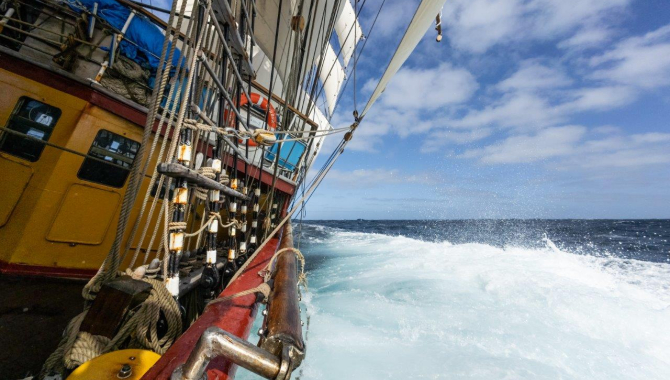Another day of trying to keep Europa as close to the Southeasterlies as possible.

Strong wind and steep seas gradually begin to calm down in the late afternoon.
About a week ago, we reached the zone where the winds come from a constant direction. We set sail, brace sharp on starboard tack, and start eating away the last few hundred miles to Walvis Bay.
Not much changed today.
Strong southeasterlies blow along the African coast north of the latitude of 30ºS, the thermometer is pretty steady at about the 20ºC. The weather is sunny, the sailing is good. But the seas are short and steep, more proper for a windy shallow coastal area than for the open ocean. The ship heels to port side and pitches, she rolls too now and then. Occasionally the short high swell break over her caprails.
The action of this constant wind, the southern edge of the Southeasterly Trade Winds, is over a large oceanic zone, and has an effect on the surface water, which is transmitted to deeper layers as well. Here it is not just the current flowing with this wind that we have, but we feel too its interactions with the east flowing general circulation further south and the disturbances coming from the currents in the Indian Ocean. A combination of wind and seas that steepens the waves, making for good sailing, though not the most comfortable.
A look at the forecast tells about easing winds and turning to more of a southerly at a shorter distance from the shoreline, conditions which we started experiencing from later in the afternoon today. Yet we still have one more night sailing in the same way ahead, as close to the wind as possible, before having a chance to brace square and make our way more downwind towards Walvis Bay, now 225nm away from us.
As the African coast lies closer and closer, we see an increasing amount of shipping traffic. During every Watch, cargo ships are spotted, some of them relatively close. And a look at the ship’s instruments reveals even a larger number of them in transit offshore Namibia. Now done by big vessels under engine, the world trade and commerce started in the era of sailing ships. The discovery of the scale of the general wind patterns, the finding of the Trade Winds and their worldwide characteristics, allowed for long transoceanic trading voyages with a better understanding of the weather patterns and thus, a better routing of their sailing passages. Showing once more a link between the constant seeking for knowledge and exploration, the influence of the climate, the circulation of seas and the atmosphere of World commerce, and eventually on the progress of civilization.



